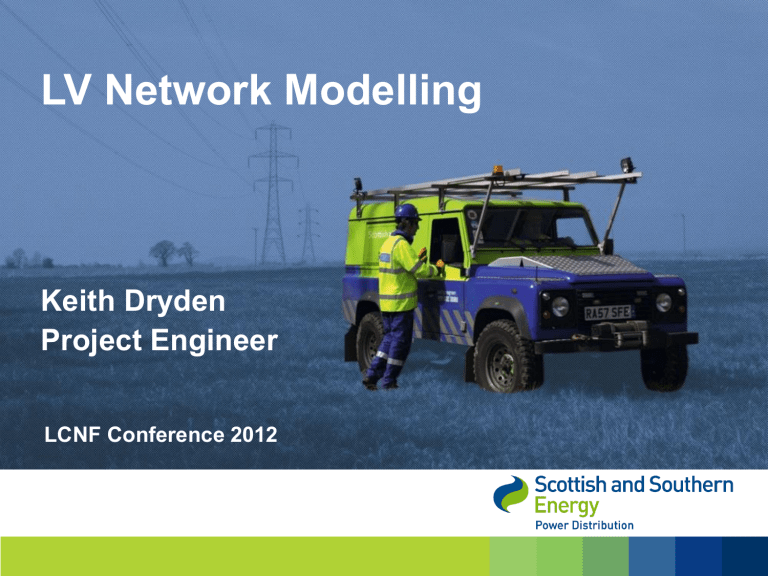PowerPoint File

LV Network Modelling
Keith Dryden
Project Engineer
LCNF Conference 2012
Overview
– Drivers
– Existing Power Analysis Tool
– Aim
– Data Flow Diagram
– Implementation
– Existing GIS data
– Transfer to Electric Office
– Transfer to CYMDIST
– Load and Generation Profile Manager
– Load Flow Analysis
– User Cases
– Summary
Drivers
• Problem statement
– There is a need to enhance the capability of SSEPD’s operational Information Systems, to facilitate the anticipated development of the low voltage network
– Modelling tools require accurate network data, but re-drawing of the network in the chosen package is time-consuming and costly, with scope for introducing error
– Traditional methods of modelling electrical networks rely on accurate customer loading data; this will become more important when Small-Scale Embedded Generation (SSEG) / Distributed
Generation is added to the system.
Existing Power Analysis Tool
2
6
1
3
5
7
11
4
8
CABLE TYPES USED IN THIS NETWORK
Node 1 to Substation 100: WAVE 300mm, 25m
Node 1 to Node 2
Tapered section 1: WAVE 95mm, 180m
Tapered section 2: WAVE 185mm, 70m
Node 1 to Node 3: WAVE 300mm, 25m
Node 3 to Node 4
Tapered section 1: WAVE 95mm, 160m
Tapered section 2: WAVE 185mm, 90m
Node 3 to Node 5: WAVE 185mm, 25m
Node 5 to Node 6
Tapered section 1: WAVE 95mm, 135m
Tapered section 2: WAVE 185mm, 115m
Node 5 to Node 7: WAVE 185mm, 25m
Node 7 to Node 8
Tapered section 1: WAVE 95mm, 110m
Tapered section 2: WAVE 185mm, 140m
Node 7 to Node 9: WAVE 95mm, 25m
Node 11 to Substation 100: WAVE 185mm, 1m
9
Power Analysis Tool Evaluation
• Three Power Analysis Tools evaluated
CYMDIST from CYME
PowerFactory from DigSilent
WinDEBUT from EA Technologies
• Chose CYMDIST
Energy Profile Handling
Integration options with Smallworld Electric Office
Engagement with the supplier, CYME
Aim
• To Model an LV network capturing data electronically from old and new information systems.
– Customer Network data in GIS transferred into suitable format
– Integration of Network Modelling Environment with Power
Analysis Tool
– Modelling and management of new low carbon devices/distributed generation
– Accept half hourly load profiles
– Run multiple scenarios or variants e.g. 1 day / 1 month / 1 year
Data flow diagram
Implementation – Existing GIS data
Implementation – Transfer to Electric Office
– Large expandable database facility.
– Electric Office allocates customer phasing.
– Single line representation of 3 phase connectivity.
Implementation – Transfer to CYMDIST
– Re-creates network
– Performs calculations on data
– Sends to the results to
Electric Office
– Normal use - no visibility
– Selected users can access for in-depth analysis
Load Flow Analysis
CYMDIST Load Distribution
Load and Generation Profile Manager
• Energy Profiles Manager in CYMDIST
• Multi Year, future and past
• Individual End Points / Customer Types
• Load and Generation
• Analysis for specific time points, and ranges
User Cases
• Operational Staff
– Quick and simple method of confirming a back-feed or mobile generation is within limits
• Desktop quoter
– Simple check against whether new load or generation can connect onto network
• Network planner
– Allow modelling of load/generation growth up to 5 years in advance. New large scale development planning.
Summary
– Appropriate modelling tool evaluated and tested with Electric
Office
– Proof of concept model completed – tested with various load profiles
– User cases established
– Forms the basis of the system for use in the
New Thames Valley Vision project
END







